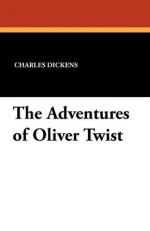|
This section contains 283 words (approx. 1 page at 400 words per page) |

|
Oliver Twist Summary & Study Guide Description
Oliver Twist Summary & Study Guide includes comprehensive information and analysis to help you understand the book. This study guide contains the following sections:
This detailed literature summary also contains Bibliography and a Free Quiz on Oliver Twist by Charles Dickens.
Oliver Twist, published in 1838, is one of Charles Dickens's best-known and well-loved works. It was written after he had already attained success as the author of The Pickwick Papers. It has been adapted as a film and a long-running Broadway musical and has been considered a classic ever since it was first published. The book originally appeared as a "serial"; that is, each chapter was published separately, in order, in a magazine called Bentley's Miscellany, of which Dickens was editor. Each week, readers waited avidly for the next installment in the tale; this partly accounts for the fact that each chapter ends with a "cliff-hanger" that would hold the reader's interest until the following chapter was published.
Dickens uses the characters and situations in the book to make a pointed social commentary, attacking the hypocrisy and flaws of institutions, including his society's government, its laws and criminal system, and its methods of dealing with poor people. Interestingly, he doesn't suggest any solutions; he merely points out the suffering inflicted by these systems and their deep injustice. Dickens basically believed that most people were good at heart but that their good impulses could be distorted by social ills.
After publishing Oliver Twist, Dickens went on to write Nicholas Nickelby, The Old Curiosity Shop, Barnaby Rudge, American Notes, Martin Chuzzlewit, Dombey and Son, David Copperfield, Bleak House, Hard Times, Little Dorrit, A Tale of Two Cities, Great Expectations, Our Mutual Friend, and The Mystery of Edwin Drood. After 1858 he often toured, reading out loud from his works to huge audiences; every new piece from his pen was eagerly awaited, and he was perhaps the most famous and best-loved author who has ever lived.
Read more from the Study Guide
|
This section contains 283 words (approx. 1 page at 400 words per page) |

|



